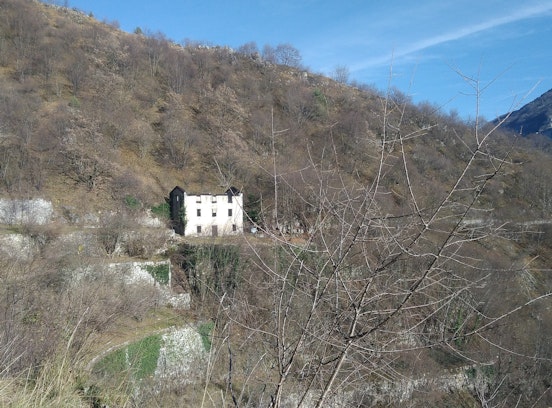SHELTER
EU ITA-AUT SHELTER: Smart Rural Heritage along Tourism Routes
- Deutsch
- English
- Italiano
- Project duration: -
- Project status: finished
- Funding: FESR (EU funding / Project)
- Total project budget: €862,200.00
- Website: https://interreg-shelter.eu/
- Institute: Institute for Renewable Energy
Project SHELTER originates from the problem represented by the abandonment and degradation of historic rural buildings in the Italian-Austrian cross-border area. A significant issue, that has such consequences as the increase of hydro-geological risk and the decrease of biodiversity, the loss of productive land and of a rich cultural heritage. To confront this problem, the project aims at joining the conservation of buildings with the development of the mountain landscape, recovering exemplary cases of abandoned heritage to insert in the existing network of hiking and cycling routes, combining it with local association and production activities. SHELTER will start from the knowledge base offered by past European projects for the sustainable recovery of historical rural heritage. Experimenting this know-how, infrastructure works will be implemented for the recovery of buildings and paths to support a new use of heritage and to sustain local development, accompanied by participation workshops with the population. In this way a catalogue of building solutions and a set of indicators will be defined, which will be disseminated between administrations and enterprises through meetings with sector and trade associations. In short, the project will develop tools and test new functionalities for the recovery historic rural buildings and their landscape, supporting their conservation and sustainable use in the current context.
|
- SHELTER contribuisce al Numero di siti di interesse naturale e culturale valorizzati (OI4) tramite il recupero e la creazione di nuovi percorsi per il turismo eco-sostenibile in luoghi di alto valore paesaggistico e ambientale. Il contributo può essere quantificato in 3 siti che beneficiano direttamente delle attività e 45 siti stimati vicini a quelli dove si interverrà a cui il know-how del progetto sarà trasmesso e potrà essere replicato. - SHELTER incrementa il Numero di nuovi prodotti per la valorizzazione dell’attrattività del patrimonio naturale e culturale (OI5) tramite la realizzazione di 3 nuovi percorsi di visita al patrimonio rurale (edifici rurali e itinerari collegati) e di 2 strumenti di progettazione a sostegno alle amministrazioni pubbliche (il repertorio costruttivo e il set d’indicatori di valutazione). - Il progetto va ad aumentare il Numero di imprese che ricevono un sostegno non finanziario (CO04) tramite il know-how elaborato e trasmesso per il recupero e la valorizzazione del patrimonio rurale. Si è stimato un numero di 120 imprese a cui sarà trasmesso il repertorio di soluzioni costruttive e lo strumento di valutazione elaborati dal progetto, passando attraverso i network in cui sono inseriti i Partner e gli Associati. |
- Il progetto incrementa la Superficie degli habitat beneficiari di un sostegno finalizzato al raggiungimento di un migliore stato di conservazione (CO23) attraverso gli interventi di recupero, conservazione e valorizzazione dei 3 siti nei Comuni partner. Si può quantificare in una superficie pari a 10 Ha (100 mila metri quadri) la superficie degli habitat beneficiati, attraverso un calcolo estimativo delle aree
Bottino-Leone D, Exner DE, Adami J, Troi A, Balest J (2024)
MDPI AG
Journal article
Buildings
More information: http://dx.doi.org/10.3390/buildings14020518
Giacovelli G (2024)
Trento: Kellermann Editore
Authored book
Fallstudie zu energetischen Sanierung im Interreg-Projekt SHELTER
Exner D, Haas F (2022)
Bozen: Eurac Research
Report
Fallstudie zu energetischen Sanierung im Interreg-Projekt SHELTER
Exner D, Haas F (2022)
Bozen: Eurac Research
Report
Caso studio per riqualificazione energetica nel progetto Interreg SHELTER
Bottino Leone D, Lucchi E, Cittati VM, Balest J, Adami J, (2022)
Bozen: Eurac Research
Report
Caso studio per riqualificazione energetica nel progetto Interreg SHELTER
Bottino Leone D, Lucchi E, Cittati VM, Balest J,Adami J (2022)
Bozen: Eurac Research
Report
Balest J, Lucchi E, Haas F, Grazia G, Exner D (2021)
Conference proceedings article
Conference: SBE21 - Sustainable Built Heritage | online | 14.4.2021 - 16.4.2021
More information: https://sbe21heritage.eurac.edu/paper-918717/
Balest J, Lucchi E, Haas F, Grazia G, Exner D (2021)
Conference proceedings article
Conference: SBE21 - Sustainable Built Heritage | online | 14.4.2021 - 16.4.2021
More information: https://iopscience.iop.org/article/10.1088/1755-1315/863/1/0 ...
Cittati VM, Balest J (2021)
Presentation/Speech
Conference: FARO Convention | Naples | 16.12.2021 - 17.12.2021




